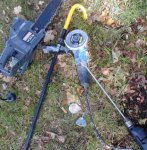Re: seacast
I'm updating this, seacast is just about finished, I ended up installing a 1/2" plywood back wall , slipped inside the transom slot. The bilge area in the center was completely rotted out so I had to put something there.
I used 10oz cloth , both sides of the ply , braced it in the transom slot with blocks and poured the seacast in. I used a LOT less resin than planned.
The seacast is still almost 2 inches thick and solid as rock.
As someone else said, the actual mixing and pour is a non event, true enuf.
I ordered 2 buckets of seacast, and still have the second one unopened but need a bit more to do the cap and sides.
I'm certain that this stuff can be made with resin, thickener , chop'd fibre and BPO catalyst, the cabosil iws needed to prevent the resin from draining to the bottom, it keeps the fibre suspended. BPO is available from the company that makes it (itsw not widely qavailable), but in the end theres not much of a savings, might as well just let seacast do it.
Now I'm moving on to the 2 main stringers, they're rotted.
I started ripping them out,
Photo #1 cut the deck off to get at them, foam seems ok too.
Photo#2 looking fwd from stern, wood is bad...slightly.
Photo#3 Wood gone. I'll glue new stringer to foam and glass to hull.
Question...
Can seacast be used to bed the stringers or is it too hard?
It would greatly simplify installing the stringers.
My plan is to cut stringers from 3/4 ply, glass both sides, seal edges, pour seacast into the slot left by the old stringer and brace it in place, then run glass tape to seal the bottom joint. Finish with coat of white bilge gelcoat resin.


























